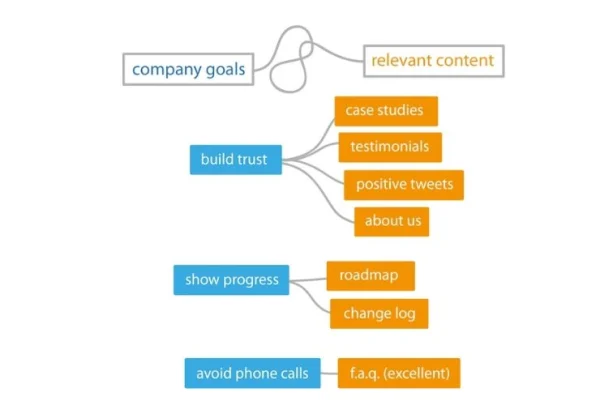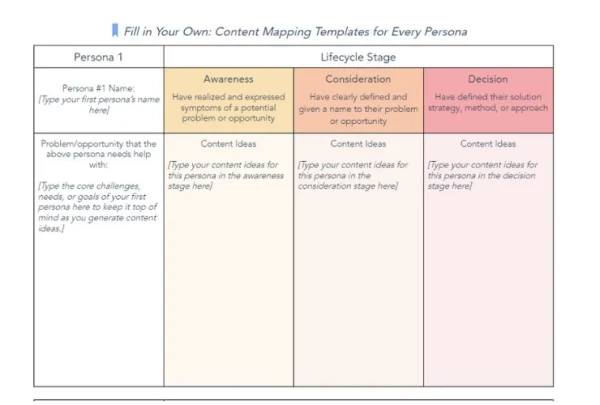Introduction
Content mapping allows businesses to create personalized content for their website, tailored to different stages of the customer journey. This approach nurtures leads and guides them toward making purchasing decisions more quickly.
In this article, we will explore what content mapping is and how you can start implementing it for your business to enhance your marketing efforts.

1. What is Content Mapping?
Content mapping is a strategic plan that delivers relevant content to the right people at the right time. It aligns with the characteristics of the target audience at each stage of their buyer journey, offering tailored content that addresses their needs.
Each piece of content in a content map is designed to meet the needs of the buyer at a particular stage in their journey, with the ultimate goal of driving them to make a purchasing decision.
Example: If your company is launching a new website, the content map would be based on why customers would need to visit your site. If customers are looking for reliable and valuable solutions, the content on your site should build trust in your company.
2. Why is Content Mapping Important?
Content mapping helps in creating a plan that produces personalized and engaging content for potential customers.
No one-size-fits-all approach works in content marketing. Different customers search for different types of information depending on where they are in their buying journey.
By diversifying content to match what potential customers are looking for, you increase the chances of generating quality leads. Content mapping is the first step to achieving that.
3. Steps to Build a Content Map
3.1 Define Your Buyer Personas
Buyer personas are detailed profiles of your ideal customers. These personas help you understand who your customers are and tailor content to fit their unique needs, behaviors, and habits.
Example: For a B2B software company, buyer personas might include IT managers looking for security solutions or marketing executives seeking automation tools.
3.2 Identify the Customer Journey
Understanding where your audience is in their buying journey is just as important as knowing who they are.
Typically, the customer journey consists of three stages: Awareness, Consideration, and Decision.
- Awareness: The customer has recognized a problem or potential opportunity.
- Consideration: The customer is clearly defining their problem and looking for solutions.
- Decision: The customer is evaluating providers and deciding on the best solution.
3.3 Address Key Questions at the Awareness Stage
At this stage, customers are only just becoming aware of their problem. Your content should help them understand the problem in more detail.
Key Questions to Consider:
- What problem is the customer trying to solve?
- What information can help them identify their problem?
- How can you build trust and offer more value than your competitors?
3.4 Create Content for the Awareness Stage
Content at the Awareness stage should focus on educating the customer without pushing for a sale. You can create:
- Blog posts
- Webinars
- Ebooks
- Social media posts
Example: A blog post discussing common challenges in project management can attract leads looking for solutions to streamline their processes.
3.5 Position Your Product at the Consideration Stage
Once customers know their problem, your content should highlight how your product or service can solve it.
Example: If your company offers a project management software, showcase how it simplifies workflow, improves communication, and saves time.
3.6 Develop Content for the Consideration Stage
At this stage, your content should focus on how your product stands out from the competition. This could include:
- Comparison videos
- Whitepapers
- Product demos
Example: A whitepaper comparing your software’s features with competing tools can help customers see the unique benefits you offer.
3.7 Overcome Barriers in the Decision Stage
At the decision stage, customers are evaluating why they should (or should not) choose your product. Address common objections such as cost, reliability, or better-known competitors.
Example: If competitors offer cheaper alternatives, focus on the added value, such as superior customer support or additional features.
3.8 Build Content for the Decision Stage
Content for the decision stage should focus on closing the deal. This can include:
- Case studies
- Social proof (testimonials)
- Product demonstrations
Example: A case study showcasing how a client increased their efficiency by 30% after using your product can help potential buyers make their decision.
3.9 Link Content Across Stages
Now that you have content for each stage of the buyer’s journey, it’s time to map everything out. Tools like HubSpot’s content mapping templates can help you organize content and visualize the journey.

4. Tools for Content Mapping
Creating a content map doesn’t require complex software. You can use everyday business tools.
4.1 Google Docs
Cost: Free
Google Docs allows for collaborative content creation and supports visual content mapping.
4.2 Lucidchart
Cost: Free basic version, paid options available
Lucidchart is ideal for visual content mapping, providing easy integration with other tools.
4.3 Buyer Persona Tool (HubSpot)
Cost: Free
HubSpot’s tool helps create and manage buyer personas, providing a foundation for your content map.
4.4 HubSpot CRM and CMS Hub
Cost: Varies
These tools integrate CRM and content management, allowing for seamless customer tracking and personalized content publishing.
5. Expert Insights
Educate Your Audience
“Engaging content is essential to attracting potential customers. Spend time building relationships with your audience by educating them through regular, relevant content.”
— Adanna Austin, Marketing Dynamics Business Solutions
Provide Information Before It’s Requested
“Content mapping allows you to anticipate customer needs and provide the right content before they ask for it.”
— Laura Hogan, Digital Atlas Marketing
Tailor Conversion Paths
“When mapping content, remember that not all customers will follow the same path to conversion. Some may prefer to speak to someone directly rather than fill out a form.”
— Marc Herschberger, Revenue River Marketing
6. Conclusion
Providing the right content at the right time can increase sales and foster business growth. By addressing customer needs through personalized content, content mapping becomes the key to business success

GoldSkin > Content Marketing > A Comprehensive Guide to Content Mapping: Personalizing Your Marketing Strategy
Articles In The Same Category
Content Marketing
How to Create YouTube Content
Content Marketing
A Comprehensive Guide to Content Marketing KPI Metrics from A to Z
Content Marketing
What is Always-On Content? How to Build a Consistent Content Strategy
Content Marketing
How to Craft Engaging Marketing Content for Maximum Business Impact